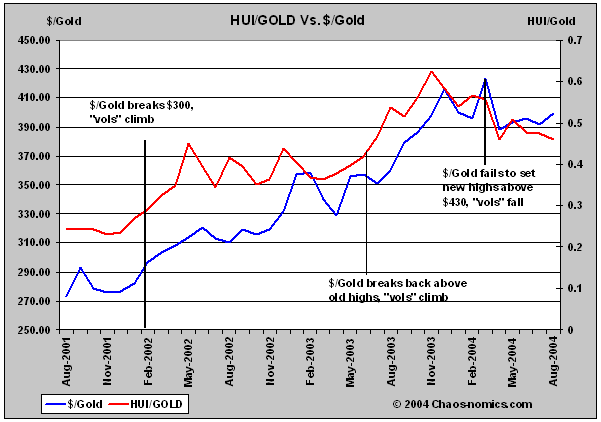 Strangely Attracted to the Truth Strangely Attracted to the Truth
Gold equities
as options, a useful heuristic
Dave Lewis
August 11, 2004
I can't recall at which site I first came across the notion that
gold mining equities, particularly the junior miners, were in
a sense, call options on gold and if I could I would commend
the author as I have since found the concept a useful heuristic.
While first entertaining the notion, the "option-ness"
if you will of the equities resided in the low p/e multiples
of the sector. For but a few $s one could buy a call option on
Gold that would only expire if the company went bankrupt. Of
late, however, I've been extending this line of thought further
as it seems to this old FX options trader that the junior miners
are once again looking like very cheap call options.
When I was
learning the trade of being an options speculator, thankfully
with other people's money, the notion of implied volatility was
somewhat difficult to grasp. I could see how it might relate
to historic or measured volatility, and why it might rise in
front of key data but not the longer term changes. One big piece
of the puzzle was revealed to me when Britain fixed the pound
within Europe's Exchange Rate Mechanism in 1990. I was managing
the GBP/$ book at the time and working closely with manager of
the GBP/DEM book. We had both positioned our books for an ERM
entry both by being long volatility and long GBP but as we didn't
know when the event would take place our exposure extended some
9 months out.
On the day
in question, Oct 8, 1990, Britain announced that the GBP would
enter the ERM within a 6% currency fluctuation band. The GBP
rose by some 5% against the US$ that week while the cross vs.
the German Mark rose by 2.5%. Implied volatility, however, did
not rise, instead, particularly on the cross, it fell quite significantly.
The reason, which was so obvious in hindsight, but which eluded
us in our prior speculations, was that once the GBP entered the
ERM, the Central Banks would ensure that volatility would stay
low. Implied volatility, particularly on the cross, stayed quite
low for the next few quarters until it became apparent that the
monetary authorities would not be able to defend the band. Readers
in search of a more academic perspective of the events are invited
to read this thesis on the subject.
This lesson
from the past sprang to mind this weekend as I examined the relation
of the HUI or unhedged gold mining equity index to the price
of Gold. The graph below depicts this relation. As you can see,
the ratio of the HUI to Gold, which can perhaps be thought of
as the implied volatility of the synthetic option discussed above,
has risen significantly over the past few years with the first
jump coming when Gold broke over $300 and the second coming when
Gold took out the old highs above $370 on its way to $400. More
recently, the ratio has fallen as if the market now feels more
comfortable that Gold will remain range bound.

To the extent
that prices for the sector continue to exhibit this option-like
behavior, I would expect to see the HUI/Gold ratio rise again
in the event that Gold breaks out above $430, or perhaps more
accurately, when the market begins to fear that Gold will break
out. Unfortunately, so long as the market believes that Gold
will remain in a range, p/e multiples in the sector may continue
to sink. Fortunately, in contrast to real options, time decay
is not a factor so I will just have to be patient and wait to
see if the yellow metal once again surprises the authorities.
To the extent that a break to new highs in Gold is seen as a
loss of Central Bank control, the rise of the HUI/Gold ratio
might be quite substantial, something for which I am willing
to wait.
 August 10, 2004 August 10, 2004
Dave Lewis
Chaos-onomics
321gold Inc

|